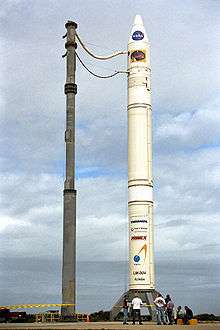Athena II
The Athena II is an American small expendable launch system which was used for three launches between 1998 and 1999,[3] and which was scheduled to return to service in 2012 but has not been flown again as of January 2017. It is a member of the Athena family of rockets, along with the smaller Athena I. Future launches would use the Athena IIc configuration, which features a different third stage.[4]
 Athena II at LC-46 with Lunar Prospector | |
| Function | Small expendable launch system |
|---|---|
| Manufacturer | Lockheed Martin Alliant Techsystems |
| Country of origin | United States |
| Size | |
| Height | 28.2 metres (93 ft) |
| Diameter | 2.36 metres (7 ft 9 in) |
| Mass | 120,700 kilograms (266,100 lb) |
| Stages | Four |
| Capacity | |
| Payload to LEO | 2,065 kilograms (4,553 lb) |
| Payload to SSO | 1,165 kilograms (2,568 lb) |
| Payload to GTO | 593 kilograms (1,307 lb) |
| Associated rockets | |
| Family | Athena |
| Comparable | Falcon 1 Minotaur IV Taurus |
| Launch history | |
| Status | Retired |
| Launch sites | Cape Canaveral LC-46 Vandenberg AFB SLC-6 |
| Total launches | 3 |
| Successes | 2 |
| Failures | 1 |
| First flight | 7 January 1998 |
| Last flight | 24 September 1999 |
| First stage – Castor 120 | |
| Engines | 1 solid |
| Thrust | 1,900 kilonewtons (430,000 lbf) |
| Specific impulse | 280 sec |
| Burn time | 83 seconds |
| Fuel | HTPB |
| Second stage – Castor 120 | |
| Engines | 1 solid |
| Thrust | 1,900 kilonewtons (430,000 lbf) |
| Specific impulse | 280 sec |
| Burn time | 83 seconds |
| Fuel | HTPB |
| Third stage (Athena II) – Orbus 21D | |
| Engines | 1 solid |
| Thrust | 189.2 kilonewtons (42,500 lbf) |
| Specific impulse | 293 sec |
| Burn time | 150 seconds |
| Fuel | HTPB |
| Third stage (Athena IIc) – Castor 30 | |
| Engines | 1 solid |
| Thrust | 258.9 kilonewtons (58,200 lbf)[1] |
| Specific impulse | 294 sec[2] |
| Burn time | 143 seconds[2] |
| Fuel | HTPB |
| Fourth stage – OAM | |
| Engines | 4 MR-107 |
| Thrust | 882 newtons (198 lbf) |
| Specific impulse | 222 sec |
| Burn time | 1,500 seconds |
| Fuel | Hydrazine |
The Athena II is a four-stage rocket, consisting of solid first, second and third stages, and a monopropellant liquid-fuelled fourth stage. The first and second stages are Castor 120s, which are also used on some versions of the Taurus rocket. An Orbus 21D motor was used as the third stage on launches during the 1990s, however when it returns to service in 2012 the Castor 30, which is under development for the Taurus II,[1] will be used instead.[4] The fourth stage is an Orbital Adjustment Module, fuelled by hydrazine and propelled by four MR-107 engines, which is used for final insertion.[5][6]
Prior to its retirement in 1999, Athena II launches were made from Launch Complex 46 at Spaceport Florida and Space Launch Complex 6 at Vandenberg Air Force Base. LC-46 will also be used for Athena IIc launches, with Launch Pad 0B of the Mid-Atlantic Regional Spaceport and Pad 1 of the Kodiak Launch Complex also offered. If a launch from Vandenberg is ordered, Space Launch Complex 8 will be used instead of SLC-6, which was rebuilt as a Delta IV launch complex following the Athena's initial retirement.[7]
During the 1990s, three Athena II launches were conducted, with one failure. Its maiden flight was conducted from LC-46 at Spaceport Florida, and lifted off at 02:28 GMT on 7 January 1997. The launch, which was the first to take place from Spaceport Florida, successfully placed the Lunar Prospector spacecraft into orbit for NASA. The next Athena II launch took place from SLC-6 at Vandenberg on 27 April 1999, with the Ikonos satellite for Space Imaging. The launch ended in failure after the payload fairing failed to separate, and as a result the rocket had too much mass to achieve orbital velocity.[8] The third launch also took place from SLC-6 at Vandenberg, on 24 September 1999. The payload, Ikonos 1, was also for Space Imaging, and successfully reached orbit.[3][9]
See also
- ALV X-1
- Comparison of small lift launch systems
- Comparison of solid-fuelled orbital launch systems
- Taurus II
References
- "Taurus II" (PDF). Orbital Sciences Corporation. Archived (PDF) from the original on 26 March 2010. Retrieved 27 March 2010.
- Kyle, Ed (26 March 2010). "Taurus II". Space Launch Report. Retrieved 27 March 2010.
- Wade, Mark. "Athena". Encyclopedia Astronautica. Archived from the original on 29 March 2010. Retrieved 27 March 2010.
- "Lockheed Martin and ATK Announce 2nd Generation Athena Launch Vehicles". Lockheed Martin. 25 March 2010. Retrieved 14 April 2012.
- Krebs, Gunter. "Athena (LLV / LMLV)". Gunter's Space Page. Archived from the original on 13 February 2010. Retrieved 27 March 2010.
- Wade, Mark. "OAM". Encyclopedia Astronautica. Archived from the original on 1 April 2010. Retrieved 27 March 2010.
- Scully, Janene (26 March 2010). "Firms team to revive Athena rocket". Lompoc Record. Retrieved 27 March 2010.
- "Lockheed: Ikonos Fell into Sea". Wired. 29 April 1999. Archived from the original on 4 November 2012. Retrieved 27 March 2010.
- McDowell, Jonathan. "Launch Log". Jonathan's Space Page. Archived from the original on 7 May 2010. Retrieved 27 March 2010.